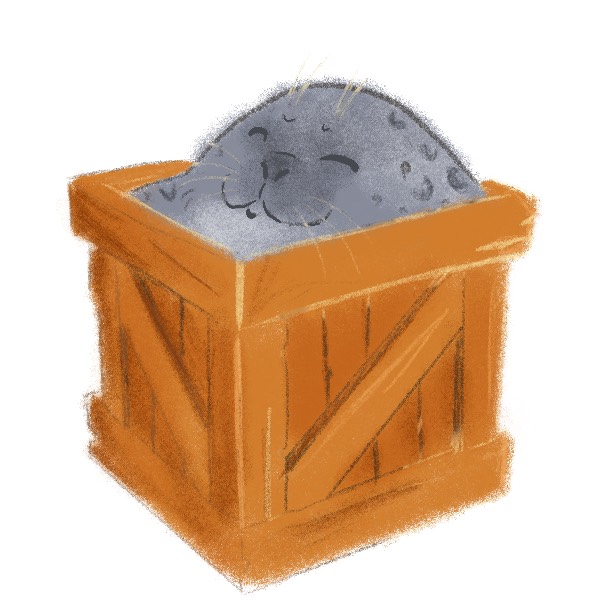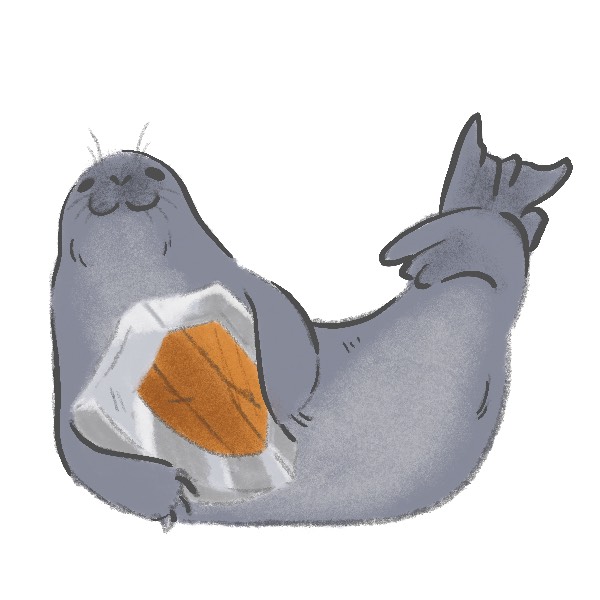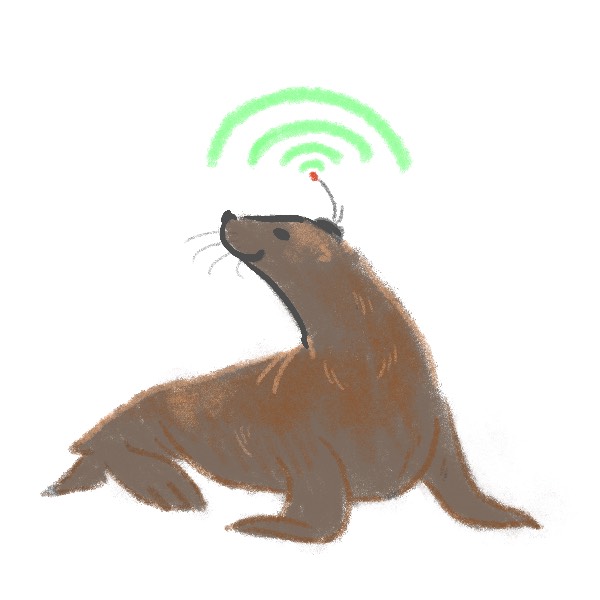Around the world, a diverse array of projects, organizations, and facilities work to help and study seals. Their approaches vary widely: from decades-spanning research missions in the remote Antarctic to bustling city aquariums serving as sanctuaries for seals unable to return to the wild. Fully equipped seal hospitals care for premature or injured pups, while disentanglement teams work to free seals from maritime debris.
Rescue & Rehab

dive deeper:
- Seal Rescue 101: Spotting & Acting
- The Rescuing Process
- The History of Seal Rescue
- Laws Governing Seal Rescue
- Seal Rescue Controversies
- Why Rescued Seals Matter
- Support the Helpers
Where seals bounce back – stronger, rounder and ready for the wild!
Rescue and rehabilitation efforts are the most direct – and most intrusive – actions to help us understand seals and their ailments, support their populations, but also show compassion for individual lives that deserve a chance at survival. Rescuing can be as swift and daring as cutting an entangled seal from a net, while rehabilitation often requires weeks or even months of extensive care, until seals suffering from malnourishment, injury, or disease get the opportunity to return to the wild.
What do they do?
-
Rescue operations can be wildly different: some are just disentanglement teams or transport seals who need care to the nearest zoo or aquarium. Some are fully-fledged care centers and hospitals. Some are wildlife stations with seal experts, some are zoos (or housed in zoos).
-
Seals are demanding patients who need specialist care from trained vets and caretakers, and they need to be cared for in a way that avoids bonding to humans if they are going to be released.
-
During this process, seal centers provide medical care and nourishment as needed and train the seals to eat fish and swim and dive, to prepare them for release back into the wild whenever possible.
-
Seal rescue is governed by law in a lot of countries – it’s regulated who is allowed to take a seal in, and under what circumstances.
-
A lot of centers also conduct research and educate the public about conservation and marine welfare.
-
You can read in detail about the process of rescue and rehablititation and even dive into the history and the legal and ethical framework of rescuing.
Why do we need them?
-
Human activities (pollution, fishing gear, habitat destruction) threaten seal populations.
-
Climate change affects food sources and survival rates.
-
Many rescued seals would not survive without intervention.
-
Seal stations and stranding centers contribute to research, improving and maintaining knowledge about seal husbandry and veterinary care, and helping to protect marine ecosystems.
-
For a more detailed dive into the topic, read about the case for seal rescue.
What can you do?
-
Seal rescuing is an expensive project, as they need long-term specialist care (sometimes up to a year!), a lot of fish, and pools with water filtration and ideally enrichment and other seals. See our guide on supporting seal rescue for learning about donations and volunteer work.
-
Spread awareness about seal conservation and threats they face.
-
Reduce pollution wherever you can and be mindful of marine habitats when visiting coastal areas.
-
Report stranded or injured seals to stranding hotlines, seal centers or the appropriate authorities. Call the experts in, don’t rescue yourself!
- Rescue/Rehab organizations Location
- A Seal Zeehondencentrum Stellendam Netherlands
- ACMOM (Océanopolis Brest) France
- Alaska SeaLife Center USA
- Aquarium de Biarritz France
- AMWRRO Australia
- Association CHENE France
- Baltic Ringed Seal Foundation Russia
- British Divers Marine Life Rescue UK
- Caithness Seal Rehab & Release UK
- California Wildlife Center USA
- Caspian Seal Research and Rehabilitation Center Kazakhstan
- CIMWI USA
- Coffs Coast Wildlife Sanctuary Australia
- Cornish Seal Sanctuary UK
- CRAM-FURG Brasil
- CRRIFS Mexico
- Ecomare Texel Netherlands
- Exploris Aquarium UK
- Fundacíon Mundo Marino Argentina
- GSPCA UK
- MOm Greece
- Hessilhead Wildlife Rescue Centre UK
- Hillswick Wildlife Sanctuary UK
- Hout Bay Seal Rescue Centre South Africa
- Island Wildlife Natural Care Centre Canada
- LPA Calais France
- Mablethorpe Wildlife Rescue UK
- Marine Mammal Alliance Nantucket USA
- Marine Mammal Care Center USA
- Marine Mammal Stranding Center USA
- Marine Mammals of Maine USA
- Marine Response Unit Australia
- MERR Institute USA
- Mexico Marine Wildlife Rescue Center Mexico
- Mystic Aquarium USA
- National Aquarium USA
- National Marine Life Center USA
- Northcoast Marine Mammal Center USA
- NY Marine Rescue Center USA
- Ocean Conservation Namibia Namibia
- Okhotsk Tokkari Center Japan
- ORCA Perú Peru
- Orkney Seal Rescue UK
- ORRCA Australia
- Pacific Marine Mammal Center USA
- Rescate de Lobos Marinos Mexico
- Riga Zoo Latvia
- Robbenzentrum Föhr Germany
- RSPCA East Winch Wildlife Centre UK
- RSPCA Mallydams Wood UK
- RSPCA Stapeley Grange UK
- RSPCA West Hatch UK
- SAAMBR South Africa
- S.O.S. Rescate Fauna Marina Uruguay
- Scottish SPCA Wildlife Rescue Centre UK
- Sea Life Blankenberge Belgium
- Sea Life Hunstanton UK
- Sea Life Scarborough UK
- Sea World Foundation Australia
- Seal Rescue Ireland Ireland
- Seacoast Science Center USA
- Seehundstation Friedrichskoog Germany
- Seehundstation Norddeich Germany
- Skegness Natureland Seal Sanctuary UK
- Spotted Seal Rescue Center China
- SR³ USA
- Stajca Morska Poland
- The Baltic Sea Animal Rehabilitation Center Lithuania
- The Marine Mammal Center USA
- The Marine Mammal Center (Hawai'i) USA
- Tynemouth Aquarium UK
- Tyulen Center Russia
- Vancouver Aquarium Marine Mammal Rescue Canada
- Virginia Aquarium USA
- WEC Netherlands
- SeaWorld San Diego USA
Where humans take action so seals can thrive!
Seal conservation is a broad and dynamic field encompassing political advocacy, hands-on observation and protection efforts on beaches, and grassroots awareness campaigns targeting individuals and organizations alike. Conservation work is often embedded in a wider vision of thriving coastal and maritime habitats where humans and wildlife coexist harmoniously. It seeks solutions to human-made challenges in a rapidly changing environment, ensuring seals can navigate their world safely and sustainably.
What do they do?
-
Conservation has many faces: building little birthing shelters for seals on remote lake shores so that they can still have their pups safely in times of melting snow drifts, or ID-ing seals via their fur patterns to gain long-term insights into their lives.
-
It can also mean talking to beachgoers and paddlers about responsible behavior when resting or pupping seals are around, or trying to find solutions for conflicts (and prejudice) where fishers and seals collide.
-
Conservation groups are monitoring seal populations and their environment and collecting data to determine impacts of human disturbance in many forms, from noise pollution by boats and other sources to our changing climate.
-
Political action is part of conservation, too: campaigns for better protection of marine mammals by law or restrictions on seal fur trade are successful examples of the past, while campaigning for marine protected areas is part of the more comprehensive conservation efforts for ocean health.
- Conservation work is especially crucial for rare and endangered species like Monk seals or freshwater seals, to ensure their small populations remain undisturbed and get optimal chances to bounce back.
-
Conservation groups can celebrate real successes – the numbers of the Mediterranean Monk Seal and the Saimaa ringed seal, even if both are still not back from the brink, have been going up due to their efforts.
Why do we need them?
-
Advocacy efforts have led to bans on harmful fishing practices, marine protected areas, and stricter regulations that directly improve seal habitats.
-
Research on seal populations informs decisions on where protections are needed most, for smarter and more impactful action.
-
When seals thrive, their habitats do too – benefiting fish stocks, biodiversity, and the health of coastal environments in a ripple effect on entire ecosystems.
-
Educated communities are more likely to support sustainable policies, donate to conservation efforts, or reduce harmful behaviors.
What can you do?
-
Donate to the efforts of seal or maritime conservation groups. Check our list below to find details and links.
-
Many groups will gladly take volunteers as their work needs countless hours of volunteer time. Our list below will provide more info!
- Inform yourself and spread the word! Responsible behavior around seals and recognition of the efforts of these conservation groups who tirelessly work towards better outcomes for seals go a long way!
- Conservation Project Location
- Akdeniz Foku Araştırma Grubu Turkey
- Atlantic Marine Conservation Society USA
- Conservação Lobo-marinho Madeira Portugal
- Coordination Mammalogique du Nord de la France France
- Friends of the Elephant Seal USA
- Friends of the Horsey Seals UK
- HMAR USA
- Marine Animal Response Society Canada
- NorthSealTeam Belgium
- Panjin Spottet Seal Protection Assosication China
- Penguin Foundation Australia
- Programa Conservacíon Foca Monje Mauritania/Spain
- Robbenschutz Klützer Winkel Germany
- Seal Research Trust UK
- Seal Sitters USA
- Seal Society of San Diego USA
- Selasetur Íslands Iceland
- Suomen luonnonsuojeluliitto Finland
- Thames Seal Watch UK
- Yellow Sea Spotted Seal South Korea
Where seal scientists meet seal scientists!
Marine mammals are mesmerizing – familiar yet almost otherworldly. To understand how they live and thrive in an environment that is vastly different from ours is one of the main goals of research on seals. Wild or trained pinnipeds participate to reveal new insights and deepen our knowledge not only of their own biology and behaviors, but of the ocean and ultimately ourselves through the intricate systems that connect all life.
What do they do?
-
Wild seals are outfitted with cameras, satellite tags, or other equipment for monitoring biometric and environmental data, to act as cartographers and explorers of the deep beyond human reach.
-
This way, they also deliver insights into their phenomenal adaptations for diving and energy-conserving.
-
Trained seals (often from zoos or rescue centers) are the stars of experiments investigating navigation, sensory perception, and cognition.
-
These seals are research partners for the ethologists, mammalogists, and trainers involved in the experiments – participating voluntarily in studies and extensively trained to understand what is expected of them.
-
Some seals play video games in scientific studies, demonstrating problem-solving skills and spatial awareness!
-
Even military researchers have studied seals, analyzing their agility and sensory abilities for applications in underwater navigation and defense. Some programs have explored how seals detect disturbances in water or locate objects, contributing knowledge that extends beyond military use and into biomimetic technology and conservation.
-
Seal rescue centers and hospitals and conservation groups contribute to research, too, gathering valuable data, conducting their own studies and publishing papers on seal husbandry and diseases or environmental factors on seal health.
Why do we need them?
-
Seals are sentinel species – studying them gives us insights into the state of marine ecosystems, helping us detect environmental changes and pollution impacts.
-
Many pinniped species face threats like habitat destruction, climate change, and human interference. Research helps us develop better protection strategies and conservation policies.
-
By learning how seals adapt to their environment, we also expand knowledge about mammal capabilities and thus human physiology – especially in fields like diving medicine, thermoregulation, and even neurology and fertility (as seals can pause their pregnancies, for example).
-
Biomimetic sensors and other applications based on the sensory equipment of seals (like artificial whiskers) could help robotic ocean exploration.
- For science! Let’s all stay curious like seals!
What can you do?
-
You can visit some of these facilities and see the experiments (and the seals!) for yourself. Check the list of centers below for more information. With your entry fee you’ll support their projects!
-
Some of the centers will take donations – in our age of anti-science sentiments it’s sadly important to support research facilities if you can. See the list below for details!
- At some places you’ll be able to volunteer, especially if you’re a student of relevant fields. Check their websites to find out more.
- Research Facility Location
- Beltran Lab USA
- Marine Science Center Germany
- Pinniped Lab USA
- Weddell Seal Science USA
Organizational Focus: Key Activities Overview
Rescue and rehabilitation may be the most visible parts of seal conservation, but they’re just one piece of a much broader range of activities.
| 🛟 Rescue | Field response to stranded or injured seals; triage care |
|---|---|
| 🏥 Rehabilitation | Medical care and recovery before release |
| 🧬 Population Monitoring | Surveys and tracking of seal numbers and movements |
| 📚 Public Education | Outreach, exhibits, and school programs |
| 🌱 Conservation | Habitat protection and species recovery efforts |
| ⚖️ Advocacy | Legal and policy work to protect seals |
| 🧪 Research | Scientific studies on seal ecology, health, and behavior |
| 🧫 Stranding Investigation | Necropsies and cause-of-death analysis for stranded seals |
A Wider Web
Not all organizations focus solely on seals; many care for a broader range of marine mammals or ocean life. Like any ecosystem – perhaps even more visibly so – the ocean is a vast, interconnected web, where each link plays a role in the health of the whole. Seals are no solo players, and seal conservation cannot stand alone. It thrives within a network of diverse organizations, each with its own focus, from habitat protection to stranding response. Together, they form a living system of care, where every part strengthens the whole.


